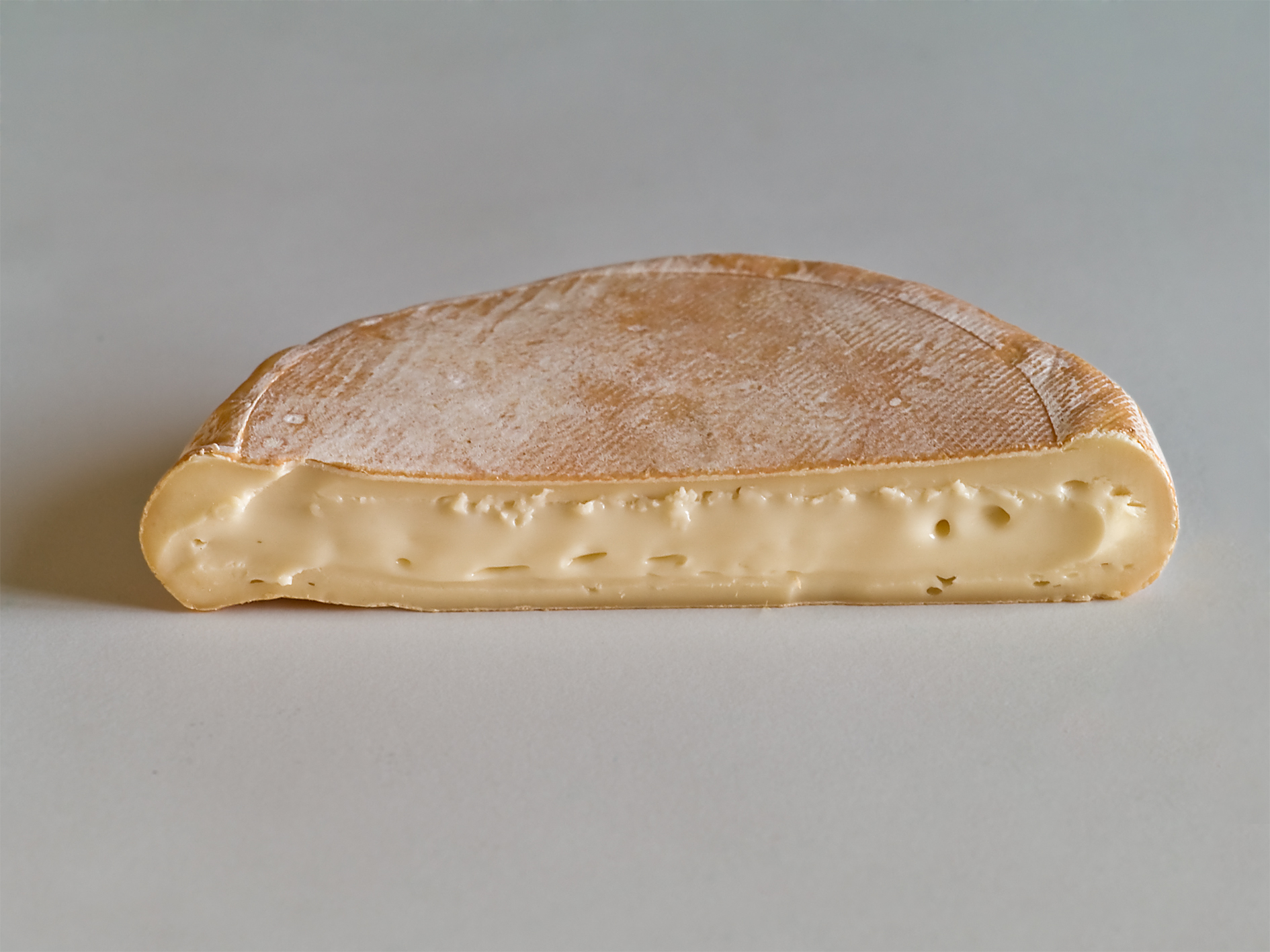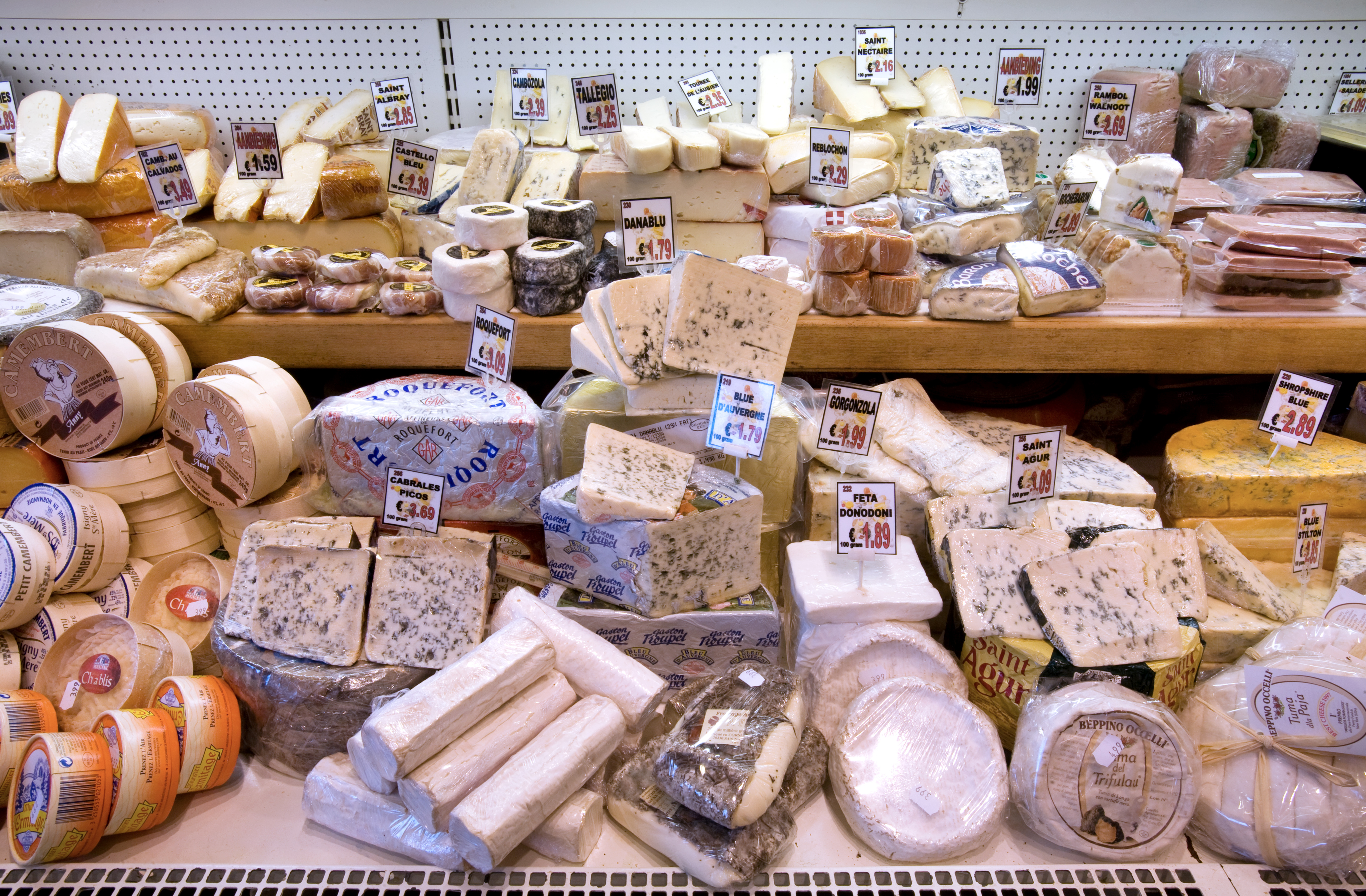|
Reblochon
Reblochon () is a soft washed-rind and smear-ripened French cheese made in the Alpine region of Haute-Savoie from raw cow's milk. It has its own AOC designation. Reblochon was first produced in the Thônes and Arly valleys, in the Aravis massif. Thônes remains the centre of Reblochon production; the cheeses are still made in the local cooperatives. Until 1964 Reblochon was also produced in Italian areas of the Alps. Subsequently, the Italian cheese has been sold in declining quantities under such names as Rebruchon and Reblò alpino. History Reblochon derives from the word "reblocher" which when literally translated means "to pinch a cow's udder again". This refers to the practice of holding back some of the milk from the first milking. During the 14th century, the landowners would tax the mountain farmers according to the amount of milk their herds produced. The farmers would therefore not fully milk the cows until after the landowner had measured the yield. The milk ... [...More Info...] [...Related Items...] OR: [Wikipedia] [Google] [Baidu] |
Tartiflette
Tartiflette () is a dish from Savoy in the French Alps. It is made with potatoes, reblochon cheese, lardons and onions. A splash of white wine can be added too. The word ''tartiflette'' is probably derived from the Arpitan word for potato (''tartiflâ'') or from the Savoyard ''tartifles'', a term also found in Provençal and Gallo-Italian. This modern recipe was inspired by a traditional dish called péla: a gratin cooked in a long-handled pan called a ''pelagic'' (shovel). Often served as an après-ski meal, tartiflette conveys an image of Alpine authenticity and conviviality. History As with many traditional dishes in the region, the potato is a staple ingredient. Savoy was historically part of the Holy Roman Empire, and the Savoyards were exposed to potato tubers earlier than the French. Tartiflette was first mentioned in a 1705 book, ''Le Cuisinier Royal et Bourgeois'', written by François Massialot and his assistant cook B. Mathieu. In its modern form, tartiflette ... [...More Info...] [...Related Items...] OR: [Wikipedia] [Google] [Baidu] |
Haute-Savoie
Haute-Savoie () is a Departments of France, department in the Auvergne-Rhône-Alpes Regions of France, region of Southeastern France, bordering both Switzerland and Italy. Its Prefectures in France, prefecture is Annecy. To the north is Lake Geneva; to the south and southeast are Mont Blanc and the Aravis Range, Aravis mountain range. It holds its name from the Savoy historical region, as does the department of Savoie, located south of Haute-Savoie. In 2019, it had a population of 826,094.Populations légales 2019: 74 Haute-Savoie INSEE Its Subprefectures in France, subprefectures are Bonneville, Haute-Savoie, Bonneville, Saint-Julien-en-Genevois and Thonon-les-Bains. The French entrance to the Mont Blanc Tunnel into Italy is in Haute-Savoie. It is noted for winter sports; the first Winter ... [...More Info...] [...Related Items...] OR: [Wikipedia] [Google] [Baidu] |
Abondance (cattle)
The Abondance is a French breed of dairy cattle. It originated in the high valleys of Haute-Savoie and shares its name with the commune and valley of Abondance and the former canton of in that region. Its area of origin lies within the former Chablais province of the Duchy of Savoy, and until the late nineteenth century it was for that reason known as the Chablaisienne. It is distributed principally in Auvergne-Rhône-Alpes and is well adapted to rough grazing on mountain terrain. It is the fourth-most numerous French breed of dairy cattle; most of the milk produced is used to make Appellation d'Origine Contrôlée cheeses such as Abondance and Reblochon. History The Abondance originated in the French or Savoyard part of the former Chablais province of the Duchy of Savoy, and until the late nineteenth century it was for that reason known as the Chablaisienne. A herd-book was started in 1891 or 1894, and the name was changed at that time to the present one. It is the ... [...More Info...] [...Related Items...] OR: [Wikipedia] [Google] [Baidu] |
French Cheese
This is a list of French cheeses documenting the varieties of cheeses, a milk-based food that is produced in wide-ranging flavors, textures, and forms, which are found in France. In 1962, French President Charles de Gaulle asked, "How can you govern a country which has two hundred and forty-six varieties of cheese?" There is immense diversity within each variety of cheese, leading some to estimate between 1,000 and 1,600 distinct types of French cheese. French cheeses are broadly grouped into eight categories, 'les huit familles de fromage'. Protected designation of origin Under the Common Agricultural Policy of the European Union, certain established cheeses, including many French varieties, are covered by a protected designation of origin (PDO), and other, less stringent, designations of geographical origin for traditional specialities, such as the EU Protected Geographical Indication (PGI). The systems has largely replaced national systems, such as the French appellation d'origi ... [...More Info...] [...Related Items...] OR: [Wikipedia] [Google] [Baidu] |
Washed-rind
There are many different types of cheese, which can be grouped or classified according to criteria such as: length of fermentation, texture, production method, fat content, animal source of the milk, and country or region of origin. These criteria may be used either singly or in combination, with no method used universally. The most common traditional categorization is based on moisture content, which is then further narrowed down by fat content and curing or ripening methods. The combination of types produces around 51 different varieties recognized by the International Dairy Federation, over 400 identified by Walter and Hargrove, over 500 by Burkhalter, and over 1,000 by Sandine and Elliker. Some attempts have been made to rationalize the classification of cheese; a scheme was proposed by Pieter Walstra that uses the primary and secondary starter combined with moisture content, and Walter and Hargrove suggested classifying by production methods. This last scheme results in 18 ... [...More Info...] [...Related Items...] OR: [Wikipedia] [Google] [Baidu] |
Thônes
Thônes () is a Communes of France, commune in the Haute-Savoie Departments of France, department in the Auvergne-Rhône-Alpes Regions of France, region in south-eastern France, and is the ″capital″ of local cheeses Reblochon and Chevrotin. Geography The Fier (river), Fier flows northwestward through the middle of the commune and traverses the village. Population People * Émile Paganon, Alpine guide and skier See also *Communes of the Haute-Savoie department References Communes of Haute-Savoie {{HauteSavoie-geo-stub ... [...More Info...] [...Related Items...] OR: [Wikipedia] [Google] [Baidu] |
Gratin
Gratin () is a culinary technique in which a dish (food), dish is topped with a Browning (food process), browned crust, often using breadcrumbs, grated cheese, egg or cheese.Courtine, Robert J. (ed.) (2003) ''The Concise Larousse Gastronomique'' London: Hamlyn The term may be applied to any dish made using this method such as Potato Bake. Gratin is usually prepared in a shallow dish of some kind. A gratin is baked or cooked under an Grilling, overhead grill or broiler to form a golden crust on top and is often served in its baking dish. A ''gratin dish'' is a shallow oven-proof container that is commonly used to prepare gratins and similar dishes. Terminology The etymology of gratin is from the French language words ''gratter'', meaning "to scrape" (from having to scrape the food out of the dish it was cooked in). The technique predates the current name, which did not appear in English until 1846 (''OED'', ''s.v.'' "gratin"). In addition to the well-known potato dishes such ... [...More Info...] [...Related Items...] OR: [Wikipedia] [Google] [Baidu] |
Evansville Courier & Press
The ''Evansville Courier & Press'' is a daily newspaper based in Evansville, Indiana. It serves about 30,000 daily and 50,000 Sunday readers. History The ''Evansville Courier'' was founded in 1845 by William Newton, a young attorney. Its first issue was printed two years before the city had a charter. The ''Evansville Press'' was founded in 1906 by Edward W. Scripps as an afternoon daily. Both papers were separate and fierce competitors until 1937, when the ''Evansville Press'' Ohio River flood of 1937, was flooded and the ''Evansville Courier'' agreed to print their competitor's paper. In 1938, the two papers formed a joint operating agreement to handle business affairs. The two papers retained separate staffs and editorial policies, but published a joint Sunday edition with two editorial pages from the two papers. The E. W. Scripps Company sold the ''Press'' and bought the ''Courier'' in 1986. The joint Sunday edition was replaced by a Sunday edition of the ''Courier.'' T ... [...More Info...] [...Related Items...] OR: [Wikipedia] [Google] [Baidu] |
List Of Cheeses
This is a list of cheeses by place of origin. Cheese is a milk-based food that is produced in wide-ranging flavors, textures, and forms. Hundreds of types of cheese from various countries are produced. Their styles, textures and flavors depend on the origin of the milk (including the animal's diet), whether they have been pasteurized, the butterfat content, the bacteria and mold, the processing, and aging. Herbs, spices, or wood smoke may be used as flavoring agents. The yellow to red color of many cheeses, such as Red Leicester, is normally formed from adding annatto. While most current varieties of cheese may be traced to a particular locale, or culture, within a single country, some have a more diffuse origin, and cannot be considered to have originated in a particular place, but are associated with a whole region, such as queso blanco in Latin America. Cheese is an ancient food whose origins predate recorded history. There is no conclusive evidence indicating wh ... [...More Info...] [...Related Items...] OR: [Wikipedia] [Google] [Baidu] |



